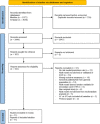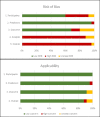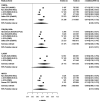Prediction of incident atrial fibrillation in community-based electronic health records: a systematic review with meta-analysis
- PMID: 34607811
- PMCID: PMC9209680
- DOI: 10.1136/heartjnl-2021-320036
Prediction of incident atrial fibrillation in community-based electronic health records: a systematic review with meta-analysis
Abstract
Objective: Atrial fibrillation (AF) is common and is associated with an increased risk of stroke. We aimed to systematically review and meta-analyse multivariable prediction models derived and/or validated in electronic health records (EHRs) and/or administrative claims databases for the prediction of incident AF in the community.
Methods: Ovid Medline and Ovid Embase were searched for records from inception to 23 March 2021. Measures of discrimination were extracted and pooled by Bayesian meta-analysis, with heterogeneity assessed through a 95% prediction interval (PI). Risk of bias was assessed using Prediction model Risk Of Bias ASsessment Tool and certainty in effect estimates by Grading of Recommendations, Assessment, Development and Evaluation.
Results: Eleven studies met inclusion criteria, describing nine prediction models, with four eligible for meta-analysis including 9 289 959 patients. The CHADS (Congestive heart failure, Hypertension, Age>75, Diabetes mellitus, prior Stroke or transient ischemic attack) (summary c-statistic 0.674; 95% CI 0.610 to 0.732; 95% PI 0.526-0.815), CHA2DS2-VASc (Congestive heart failure, Hypertension, Age>75 (2 points), Stroke/transient ischemic attack/thromboembolism (2 points), Vascular disease, Age 65-74, Sex category) (summary c-statistic 0.679; 95% CI 0.620 to 0.736; 95% PI 0.531-0.811) and HATCH (Hypertension, Age, stroke or Transient ischemic attack, Chronic obstructive pulmonary disease, Heart failure) (summary c-statistic 0.669; 95% CI 0.600 to 0.732; 95% PI 0.513-0.803) models resulted in a c-statistic with a statistically significant 95% PI and moderate discriminative performance. No model met eligibility for inclusion in meta-analysis if studies at high risk of bias were excluded and certainty of effect estimates was 'low'. Models derived by machine learning demonstrated strong discriminative performance, but lacked rigorous external validation.
Conclusions: Models externally validated for prediction of incident AF in community-based EHR demonstrate moderate predictive ability and high risk of bias. Novel methods may provide stronger discriminative performance.
Systematic review registration: PROSPERO CRD42021245093.
Keywords: atrial fibrillation; electronic health records; meta-analysis; primary care.
© Author(s) (or their employer(s)) 2022. Re-use permitted under CC BY. Published by BMJ.
Conflict of interest statement
Competing interests: MGDB was a committee member of the NICE guideline (NG196) atrial fibrillation: diagnosis and management. CPG has received grants for research from Abbott and Bristol Myers Squibb; consulting fees from Astrazeneca, Bayer and Daiichi Sankyo; honoraria for speaking at meetings and educational events from Astrazeneca, Wondr Medical and Menarini; support for attending meetings from Bayer and Bristol Myers Squibb; and has acted as an advisory board member for Amgen, Astrazeneca, Bayer, Daiichi Sankyo and Menarini. All other authors declare no competing interests, or activities that could appear to have influenced the submitted work.
Figures




References
-
- Hindricks G, Potpara T, Dagres N, et al. . 2020 ESC guidelines for the diagnosis and management of atrial fibrillation developed in collaboration with the European association for Cardio-Thoracic surgery (EACTS): the task force for the diagnosis and management of atrial fibrillation of the European Society of cardiology (ESC) developed with the special contribution of the European heart rhythm association (EHRA) of the ESC. Eur Heart J 2021;42:373–498. 10.1093/eurheartj/ehaa612 - DOI - PubMed
-
- Public Health England . Technical document for subnational English atrial fibrillation prevalence estimates: application of age–sex rates in a Swedish region to the English population, 2017. Available: https://www.gov.uk/government/publications/atrial-fibrillation-prevalenc... [Accessed 24 Mar 2021].
Publication types
MeSH terms
Grants and funding
LinkOut - more resources
Full Text Sources
Medical
Research Materials
Miscellaneous
